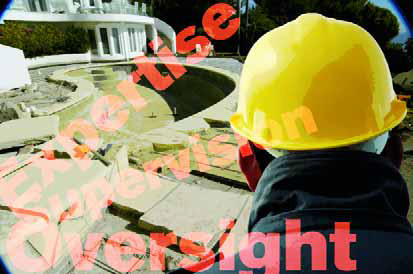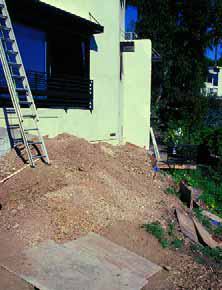Expert Oversight

In the last several of these “Details,” I’ve covered what happens in my projects before construction begins. Now we’re ready to shift gears and look at what happens on site – the place where design and execution meet.
Before we look at the way I build things, however, I want to take a hard look at common practices in the field. What I write here may seem harsh, but it’s not intended that way: To establish a baseline for doing things in what I would term the right way, I need to point to practices in our industry – particularly the pool/spa sector – that
cause problems for all of us who want to take the high road and do right by our clients.
Please be clear that these deficiencies aren’t common to everyone who builds pools. Indeed, the past decade has seen lots of watershapers step up and approach the work with skill and dignity. To illustrate a point, however, I’m going to paint a realistic picture of just how bad things can (and still do) get out there in the real world: Let’s call it a corrective suggestion rather than a wholesale indictment.
As I see it, all of our problems stem from two key factors: First, in far too many companies, the people who do the selling haven’t the slightest clue what construction is all about. They focus entirely on getting a client to sign on the bottom line and give no thought to what’s going to happen when the project is actually being built.
Second, in too many cases there’s an almost complete lack of expert field supervision during construction. In my view, this is inexcusable. In Los Angeles County, for example, the contractor is the expert of record on site. He or she makes all the calls on what’s needed, brings in geologists and soils specialists and works with engineers. When things go wrong, he or she isn’t the only one who can shut down the site – government officials can do it, too – but he or she is the only one who can reopen it when whatever caused the delay has been addressed.
How can this level of oversight be exercised by someone who’s never there? This is the worst sort of passing the buck.
‘POOL GUY’ MENTALITY
When you combine these two deficiencies – as a large number of operations do – you have a situation in which projects aren’t sold with any view to the technical realities of construction – and then the process that ensues moves forward in a free-form, haphazard way without expert oversight.
It’s sad, but all too often, it’s true.
If we as an industry were to confront and resolve just those two issues, there would be almost no limit to the great things we could achieve.
That potential is evident when you look at the growing number of firms that do things the right way. What we see in these operations is a virtual explosion of design creativity and reliably installed systems: The output is more artistic, the structures are more durable and the mechanical and control systems perform well and are easily serviced. What’s more, these companies aren’t being sued, experience less stress, have more fun, make more money and create boundlessly happy clients.
With companies on the flip side of the coin, however, the exact opposite can and does prevail. Designs tend to be weak and uninspired, the vessels can and do fail, systems are plagued by problem after problem – and the operations exist in a defensive crouch, doing little beyond trying to avoid the liability that sprouts from basic incompetence or indifference.
If you ask me, that’s a rotten way to do business – the perfect expression of what I call the “pool guy” mentality. This inadequate mindset can be traced to the industry’s origins, when pool contractors were seen as being a slight cut above purveyors of aluminum siding. The idea was (and in some cases still is) to get in and out as quickly as possible, provide products as cheaply as the market will bear, collect the money and never look back.
|
Misplaced Emphasis Every year and in some cases several times each year, large companies (and even some small ones) in the watershaping industry pull all their salespeople out of the field and sit them down for inspirational speeches and seminars intended to help them sell more and make themselves and their employers more money. There’s nothing particularly wrong with that (although I believe it builds the wrong attitudes into some of these operations), but I have a simple suggestion that might help alleviate some of the problems highlighted in the accompanying text. Why don’t each of these companies use these opportunities to help their sales staffs understand the practicalities of the products they’re selling? Why don’t they use part of that “educational” time to bring the sales staff face to face with field personnel who end up trying to build what the salespeople have sold? As I see it, an educated sales force is of tremendous value – and so is a measure of transparency between the sales and construction sides of the business. Who knows? The whole situation might improve with this simple addition to the agenda. — D.T. |
In my case, I took that standard and did just the opposite. As I see it, we work with clients to provide them with beauty, art and luxury. The thought that this service is being performed by people who don’t know the first thing about design or construction is, to me, completely disconnected from the mission of watershaping.
On that level, it’s all about standards – not building department standards or industry standards, but instead personal standards that are established, observed and maintained by companies that place value on quality.
High personal standards aren’t being maintained when a company has two or three “field supervisors” who drive around and do little more than check to see that crews are working. Those crews have been left with “designs” and sets of “plans” generated by salespeople with little or no experience in construction, let alone any sort of design background.
These plans can be filled with inadequacies – oversized pumps or undersized plumbing, for example – because poorly trained salespeople are all about dollars and revenue rather than about what’s best for the site or the client. They have no idea what’s underneath the lawn, either, and all too often fail to mention that soils conditions might make a $40,000 pool cost three or four times that much.
Scrutinizing these designs and plans is the sort of role in which an experienced, honest-to-goodness field supervisor can prove invaluable: If he or she sees that a salesperson’s or draftsperson’s plans call for a two-horsepower pump on two-inch lines, for example, he or she can advise the contractor or the company owner of the deficiency and the project may have some hope of success.
Supervision is a constant need, not a casual, occasional activity. The perils of unqualified salespeople working with absentee field supervisors shows most clearly at the gunite or shotcrete stage, where improvisations by the excavator, the plumbers, the steel subcontractor or the applicators can result in shells that are improperly sized, positioned in the wrong place, too short, too tall, too shallow, too deep – all calamities that can be overcome if roles are properly defined, salespeople are well-informed and field supervisors do more than drive from site to site to site.
And this situation isn’t much improved in operations in which salespeople are supported by production designers who crank out plan documents based on standard templates and details. These documents take no account of soils, hydraulics or materials, and once these designers hand off their “plans” to permit runners, they’re finished: All they do now, if they think about it at all, is hope that things will work out well enough so they’ll get paid rather than sued when the project is complete.
LOOKING FOR PROBLEMS
Is the above an exaggeration? I would hope so, but my observations through the past 25 years tell me otherwise. The plain truth is that the industry has its dark pockets: Although I’d be happy to sing a different tune, this is the one I’m stuck with – and writing this grim depiction is one of the few ways I have to provoke change.
To drive the point home in specific terms, let’s stick with the abovementioned issues of hydraulics and soils.
It completely blows my mind these days to see projects going in with small pipes and big pumps. There’s just no excuse for that: Information about hydraulic efficiency abounds in the industry today, and I have no idea at all how or why so many companies simply choose to ignore it.
It’s sad, but all I can think is that these companies are still selling pools with the bigger-is-better mentality most forward-thinking companies abandoned years ago. After all, a two-horsepower pump can be made to seem bigger and therefore better than a half-horsepower pump, and to keep job costs down after selling a more expensive pump, they install it on two-inch (or even worse, one-and-a-half-inch) plumbing.
Think about that: We live at a time when energy efficiency is becoming a crucial societal issue, but instead of embracing it as a core value, many pool guys stick with the old way of doing things. The simple fact is that improper hydraulic design wastes money and energy; moreover, improperly designed and installed systems almost always require more repair and maintenance – and they’re usually noisy as well.
It makes me ill knowing that it’s so easy to do things the right way – and that doing so doesn’t even drive up the cost of the job to any significant extent.
Look at it this way: If we’re really in the business of moving water, then at a minimum we should all be smart enough to understand the basic principles behind how water flows through pipes and how to make things work as efficiently and reliably as possible. And this is not new information. In fact, this idea has been covered to death in this magazine and in seminar rooms for years, thousands of times over.
And yet – right now, as you read this sentence – in this great country there are pools and spas being installed with hydraulic systems that are fundamentally unsound.
IN THE DIRT
The issue of soils carries the same weight. As with hydraulics, this is an area where there really should be no question about the expertise of the contractor, yet as I’ve mentioned in these pages before, many contractors seem to operate as though they have no responsibility to build in accordance with a site’s soil conditions.
To me, that’s an outrageous assertion. Setting aside the need for professional soils reports for the moment, let’s take a look at the issue from the practical perspective of job-site management: When you build structures that require significant excavation of the ground (as with most any swimming pool), there are going to be surprises – not on every project, of course, but on enough of them to make assuming a hazardous exercise..
 I hold fast to the idea that, although watershapers do not need to be geologists, when we are charged with managing and supervising a construction process, we should know enough to recognize the clear signs that we’ve run into unexpected conditions.
I hold fast to the idea that, although watershapers do not need to be geologists, when we are charged with managing and supervising a construction process, we should know enough to recognize the clear signs that we’ve run into unexpected conditions.
| When I arrived at the property, the view was sublime, but the ‘backyard’ space was essentially unusable – a steep slope with little to offer. |
It’s not unusual, for example, to dig the hole for a pool and find two distinctly different soil types. This is a red flag, of course: When you have a structure installed in two or more types of soil and the substructure of the shell isn’t designed to accommodate their potentially different rates of settlement or withstand the stresses of ground movement, failure will be the eventual result. The pool will crack or shift positions and destroy or separate from surrounding decks, mangle plumbing runs and turn an otherwise satisfactory project into a total, gut-wrenching mess.
What happens with companies using supervisors who are not up to speed with these issues is that they move blindly forward, ignore the situation and move on to complete the plumbing, hang the steel and gunite or shotcrete the shell as though there’s no problem.
If the contractor is lucky, a knowledgeable inspector might catch the problem and demand a soils report or some form of appropriate structural change. At that point, the inspector might have the builder remove the steel and the plumbing and install a footing or pile – thereby stopping a project in its tracks, hitting clients with substantial new costs (at least tens of thousands of dollars and often much more) at a point where their property is already ripped apart and creating a general atmosphere of distrust, anger and, in many cases, an inclination toward litigation.
Put yourself in a client’s shoes for a moment: How would you feel if you were to learn, after your backyard has been destroyed and you’ve lost a serviceable lawn, irrigation system, landscape lighting and more, that the soil under that lawn was unsuitable for ordinary construction and that it will cost you $15,000 to $25,000 even to get back to where you were before excavation began? And how angry would you be to learn that if your contractor had done the right thing and required a $4,000 or $5,000 soils report, you could’ve made the call either to expand the budget or nix the project before a blade of grass was bent?
Ironically, official intervention in projects draws complaints from watershapers, but in my view, smart inspectors are sometimes all that’s standing between contractors and certain project failure, whether the breakdown takes five months or five years. When this happens, of course, everyone scratches their heads and says, “Oh dear, it must be earth movement.” There’s no other way to describe this situation: It’s a travesty!
A CALL TO IGNORANCE
Some of you reading this may accuse me of overstating the problem or exaggerating to make a point, and others might say that the situation has improved to a degree that my comments are now out of line. If either of those counterpoints is valid in your area, my hat’s off to you – but I’d argue that exceptions don’t diminish the basic point that too many watershapers, particularly in the pool industry, operate on slippery moral slopes when it comes to soils reports and engineered responses to soil conditions.
To this day, I pick up trade magazines and see classified ads from contractors that read something like this: “Field supervisors and sales professionals needed. Will train in three weeks.” These are the firms that put ill-informed supervisors in the field and ignorant salespeople in living rooms – and moreover, they have no expectation that salespeople and supervisors will ever communicate with each other on any level.
| Now that construction is complete, my clients come home to an entirely different vista, with an elegant pool and spa in the foreground inviting them and their guests out to enjoy an even broader view of the city’s lights from the new deck. In the next several issues, I’ll describe every step of the process by which this watershape was built, from site preparation through to application of finishing touches. |
Those who own and run these companies are archetypal “pool guys,” and they continue to give our entire industry a collective black eye. And lots of them don’t care so long as the jobs keep moving along and the problems don’t get so bad that they cut too deeply into the bottom line.
What’s left out of these calculations is what happens with clients who are left in the lurch by these poor players. Sticking with soils issues and hydraulics as examples, these are the clients who will be stuck with systems that are excessively noisy, waste energy, cost a bundle to operate and experience steady strings of visits from service technicians who try to make silk purses from sow’s ears. And all too often, these are clients who, at some point, will be informed by those technicians that their shells have cracked or moved with disastrous effects.
These are ugly scenarios that play out too often in markets around the country.
At best, the clients will come away with negative attitudes about owning watershapes, and you can bet they won’t be shy about sharing their insights more of their friends than our most satisfied clients ever will. At worst, these clients will pursue litigation, always resentful that instead of relaxing in luxury by a pool, they’re spending their time in courtrooms seeking compensation and revenge for jobs poorly done.
To watershapers who cut corners or deliberately ignore soils conditions and hydraulic efficiency – and then make excuses when things go terribly wrong – I pose this simple question: How would you feel if the roles were reversed and you were the one spending thousands upon thousands of dollars for the privilege of wallowing in anger and frustration?
The answer is obvious, so why on earth are self-styled “professionals” in our industry willing to do that to others?
THE SIMPLEST CONCERNS
I could go on to construction issues beyond soils conditions and hydraulics, but I think you get my point.
When we go onto someone’s property and install a swimming pool or some other type of watershape, it’s a terribly intrusive process. We rip up the yard, make lots of noise, impede access to driveways, disturb neighbors – and it all runs on for a period in which the client experiences what can best be described as chaos at first hand. From my perspective, skillful project management and supervision are all about minimizing the effects of these disruptions.
It all starts with thoughtful, detailed, well-informed communication: Clients need to know what they’re in for, how it all will be managed and how long it’s going to take – and then it’s up to us to meet those expectations.
But even in the simplest ways, I’ve seen projects where the fundamentals are seemingly ignored. This one kills me: I’ve been on many sites where there’s no portable toilet for workers. Not to put too fine a point on it, but when you have crews on site eight or more hours a day, if they don’t have a place to go, they have no choice but to find places to relieve themselves (discretely, one would hope).
Reverse roles again and imagine this is your backyard filled with strangers using your bushes as lavatories. I wouldn’t want my wife or children seeing that or even suspecting it might be happening. And just as bad are those situations in which a porta-potty appears on site but is dropped without thought in front of, say, a kitchen window or a neighbor’s kitchen window.
This may seem a minor detail, but I guarantee you that as weeks and months pass, items such as this become major issues for clients. Think parking for crew vehicles, for example, or access to the yard, materials storage, site clean up, standards for crew behavior and protecting a home from dust, debris and incidental damage: Too often these issues are ignored or addressed casually. They may or may not ever become issues, but in my view and, believe me, in the view of every single one of my clients, these things should be considered and discussed before you disturb a single blade of grass on the property.
And don’t get me started on contractors who leave it to clients to wet down shells to ensure proper curing. I consider this utterly inappropriate and unprofessional: A few clients may be involved enough not to mind, but what happens if they don’t follow through as asked? The solution is simple: Either rig up a soaker system with a timer, or send someone to the site as needed to get the job done properly!
The key is that none of these issues requires an advanced degree in anything other than common sense: It’s all about accommodating clients’ needs and doing your work courteously and properly.
NOT THAT TOUGH
In my own operation, what I do on site is basically the oposite of what I’ve been describing here. There is no separation at all between sales, design and supervision; all projects are designed with proper hydraulic and with full knowledge of soil conditions; and I inspect every site and conduct pre-construction meetings to cover every detail of on-site performance with all crews.
As is true in any endeavor that requires expertise, education is the key. That’s a familiar refrain, but it’s the only way that anyone, no matter how natively intelligent, can truly understand what it is to be a true designer or know the ropes about project supervision and job-site management.
You can find this education in the classroom, or you can get it through experience – and most of us need and benefit from both. Of course, I’m probably preaching to the saved, as those of you who read WaterShapes and my columns already know all this – a fact reflected in the full classrooms at trade shows and at our Genesis 3 events.
As always, the first step toward improvement is recognition of deficiencies and a conscious decision to set yourself on a better path. If you do so and incorporate in some measure the approach to construction I will lay out in the next several issues of this magazine, my suspicion is that your work will get better and better, you’ll make more money and you’ll live with fewer hassles. The work will be more fun, you’ll derive more personal satisfaction from what you do, you’ll stay out of court and you’ll find yourself with a stable of happier clients.
If you don’t see it as being worth the effort of learning to do things the right way, do yourself and the watershaping industry a favor: Ever consider finding another line of work?
David Tisherman is the principal in two design/construction firms: David Tisherman’s Visuals of Manhattan Beach, Calif., and Liquid Design of Cherry Hill, N.J. He can be reached at [email protected]. He is also an instructor for Artistic Resources & Training (ART); for information on ART’s classes, visit www.theartofwater.com.












